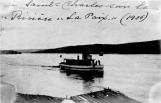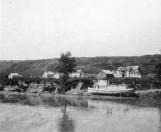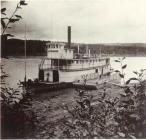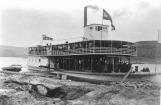1
In total there were seven steamboats, including tugs, used on the upper Peace River, beginning with the S.S. St. Charles in 1903 and concluding with the S.S. D.A. Thomain 1930. In this storyline we will take a brief suvey of these steamboats.2
The S.S. St. Charles.1906
Peace River Crossing, Alberta, Canada
 Credits:
Credits:Missionary Oblates, Grandin Collection at the Provincial Archives of Alberta, OB 13501
3
The earliest steamboat on the upper Peace River was the S.S. St. Charles, built by the Oblates at the St. Augustine Mission on the Shaftesbury Trail, just south of the modern day Town of Peace River. The boat was launched in May of 1903 and was to operate on the Peace River until 1915.Design: a small boat powered by a screw propeller mounted on the stern.
Builder: the plans and machinery (engine, boiler and propeller) were apparently purchased from an unknown company in Peterborough, Ontario. The boat was assembled by the Oblates at the St. Augustine Mission in the winter of 1902-3 utilizing wood cut with their saw mill there.
Details: the S.S. St. Charles was 60 feet in length and 12 feet wide. It had a gross tonnage of 28.9 and a registered tonnage of 19.5.
Ownership: Oblates of St. Augustine Mission (1903-1910; Ford and Lawrence (1911-1915). Grounded in 1915 and dismantled in 1916-7.
4
The S.S. St. Charles "dry docked" at the St. Augustine Mission on the Peace River.Circa 1903-1911
St. Augustine Oblate Mission, Shaftesbury Settlement, near Peace River, Alberta, Canada
 Credits:
Credits:University of Alberta Archives, Arthur Watts Fonds, UAA 76-50-14-240
5
The S.S. Peace River was built by the Hudson's Bay Company at Fort Vermilion in the winter of 1904-5. It was built to haul freight and passengers from the Vermilion Chutes as far as Hudson's Hope in British Columbia. It was to be used by the Company from 1905 to 1915.Design: the S.S. Peace River was a stern-wheeler which utilized a steam powered paddlewheel. The Hudson's Bay Company, based on its experiences on the Athabasca River and other northern waterways, wanted a size of boat which could offer passenger and freight service at a relatively high speed in comparison with the S.S. St. Charles. The design was produced by the Marine Iron Works of Chicago in consultation with Hudson's Bay Company staff.
Builder: the S.S. Peace River was built at the Hudson's Bay Company post at Fort Vermilion by Alex Watson. The machinery components were made by the Marine Iron Works (Chicago) and shipped to Fort Vermilion where Watson and his crew utilized the saw mill at the Hudson's Bay Company to cut the components of the superstructure.
Details: the S.S. Peace River was 110 feet long and 24 feet in width. It had a gross tonnage of 282 tons and a registered tonnage of 184 tons. It utilized two engines and a pair of marine boilers.
Ownership: the S.S. Peace River was owned by the Husdon's Bay Company from 1905-1915. It was abandoned after the 1915 sailing season.
Sources:
There is a tremendous amount of detail available on the S.S. Peace River in the Hudson's Bay Company Archives at the Archives of Manitoba in Winnipeg. This includes:
1) B.224/a/34. The Log Book of the Peace River, 1906-1913
2) A.12/FT341/11 ' Peace River Transport and Navigation, 1903'.
3) A.12/FT341/11 'S.S. Peace River 1903-1916'.
6
The S.S. Peace River.Circa 1905
Peace River Crossing, Alberta, Canada
 Credits:
Credits:Peace River Museum, Archives & Mackenzie Centre, 75.622.006
7
The S.S. Peace River.Circa 1905-1916
Peace River Crossing, Alberta, Canada
 Credits:
Credits:Peace River Museum, Archives & Mackenzie Centre, 73.568.002
8
When the Hudson's Bay Company decided to operate the S.S. Peace River on the upper Peace River beginning in 1905 they also decided to add a steam tug to their Peace River "fleet". The chosen vessel was the Messenger. It was used primarily for late seasons (August to October) runs from Fort Vermilion to as far away as Fort St. John in British Columbia.Design: the Messenger was a screw propeller design tug capable of carrying limited freight and passengers.
Builder: the Messenger was built in Kenora, Ontario in 1897 by an unknown builder for the Hudson's Bay Company.
Details: the Messenger was 33 feet long and 7 feet wide. It had a gross tonnage of 5 tons and a registered tonnage of 3 tons. The Messenger was the smallest steamboat to sail on the upper Peace River.
Ownership: the Messenger was owned by the Hudson's Bay Company from 1897 to 1914. It was apparently abandoned at Peace River Crossing in 1914.
Sources:
There is a detailed description of travel on the Messenger in Hulbert Footner's New Rivers of the North. Footner traveled on the boat with several passengers in 1911.
Note:
There were several vessels registered in Canada that went by the name of the Messenger (over 60), including at least one other steam tug used by the Hudson's Bay Company.
9
The Hudson's Bay Company tug Messenger at the Saint Henri Mission, Fort Vermilion.1911
Fort Vermilion, Alberta, Canada
 Credits:
Credits:University of Alberta Archives, Hulbert Footner Fonds, UAA 77-147-79
10
The Hudson's Bay Company steam tug, the Messenger, at Peace River Crossing.1911
Peace River Crossing, Alberta, Canada
 Credits:
Credits:University of Alberta Archives, Hulbert Footner Fonds, UAA 77-147-41
11
Passengers loading a reluctant cow onto the S.S. Grenfell.Circa 1912-4
Peace River Crossing, Alberta, Canada
 Credits:
Credits:Peace River Museum, Archives & Mackenzie Centre, 81.1194.089
12
Wood is being gathered as fuel for the S.S. Grenfell.Circa 1912-4
Peace River Crossing, Alberta, Canada
 Credits:
Credits:Peace River Museum, Archives & Mackenzie Centre, 81.1194.097
13
The S.S. Athabasca River was built by the Hudson's Bay Company at Athabasca Landing in 1912 and was subsequently moved to the Peace River in 1915. It was to steam on the Peace River through the 1919 season after which it was de-commissioned and turned into a warehouse at Peace River Crossing.Design: the S.S. Athabasca River was a stern-wheeler, designed and built by J.W. Mills for the Hudson's Bay Company.
Builder: J.W. Mills. Mills utilized two steam engines previously used by the S.S. Hazelton.
Details: the S.S. Athabasca River was 136 feet long and 28 feet wide. It had a gross tonnage of 340 tons and a registered tonnage of 230 tons. It employed two steam engines made by the Albion Iron Works previously used by the S.S. Hazelton.
Ownership: the S.S. Athabasca River was owned throughout its time on the Peace River by the Hudsons's Bay Company.
Sources:
Hudson's Bay Company Archives, Archives of Manitoba, A.12.Ft/341.1 'S.S. Athabasca River & Northern Transport, 1911-17'.
Note:
The S.S. Athabasca River which operated on the upper Peace River should not be confused with the S.S. Athabasca, launched on the Athabasca River in 1888 and the S.S. Athabasca River , built at Fort McMurray in 1922.
14
The S.S. Athabasca River at Peace River Crossing.9 May 1913
Peace River Crossing, Alberta, Canada
 Credits:
Credits:Peace River Museum, Archives & Mackenzie Centre, 75.622.024